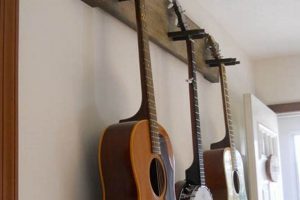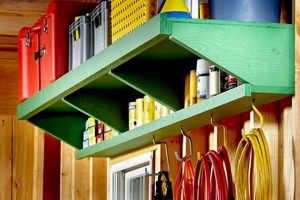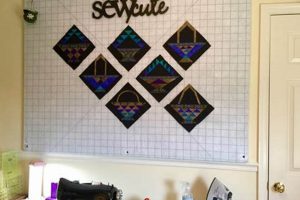The creation of a decorative wall feature using flowers as the primary medium is an increasingly popular practice for events, photography, and interior design. These features often involve assembling artificial or fresh blooms onto a supporting structure to form a visually appealing background. For example, individuals may construct such a display using a variety of silk flowers attached to a plywood board for a wedding reception.
Such floral installations offer a cost-effective and customizable alternative to traditional decorations. Their aesthetic appeal can transform any space, providing a memorable backdrop for photographs and gatherings. Historically, the use of flowers for ornamentation dates back centuries, with modern adaptations allowing for greater accessibility and creative expression.
The subsequent sections will delve into the specific materials required, the various techniques employed in their construction, and the diverse design possibilities available when creating these eye-catching displays.
Floral Wall Creation
The following guidelines offer valuable insights into ensuring a successful and visually impressive floral wall construction.
Tip 1: Material Selection: Choose floral elements appropriate for the intended environment. Artificial flowers offer longevity and resilience for extended display or outdoor use, while fresh flowers provide natural fragrance and aesthetics but require careful maintenance and a shorter display period.
Tip 2: Structural Integrity: Ensure the supporting structure is robust and capable of bearing the weight of the floral arrangement. Consider the size and density of the design when determining the necessary framework, particularly for large installations.
Tip 3: Color Palette Coordination: Establish a cohesive color scheme that complements the surrounding environment and aligns with the overall aesthetic goals. Employ color theory principles to achieve visual harmony and avoid clashing elements.
Tip 4: Attachment Techniques: Select appropriate adhesives or fastening methods to securely attach the floral elements to the backing. Hot glue, floral wire, and cable ties are common options, each offering varying degrees of strength and suitability for different materials.
Tip 5: Scale and Proportion: Consider the size and scale of the wall in relation to the surrounding space. A design that is too small will appear insignificant, while one that is too large may overwhelm the area. Adjust the design to achieve a balanced and visually appealing composition.
Tip 6: Pre-Assembly Planning: Before commencing the final assembly, lay out the floral elements in a preliminary arrangement to visualize the overall design and make any necessary adjustments. This allows for experimentation and ensures a more cohesive and intentional final product.
Tip 7: Lighting Considerations: Incorporate appropriate lighting to enhance the visual impact of the display. Spotlights, string lights, or ambient illumination can accentuate the texture and color of the flowers, particularly in low-light environments.
These insights emphasize the importance of meticulous planning and execution in achieving a visually striking floral wall display. Careful consideration of materials, structure, and design principles are paramount for a successful outcome.
The subsequent section will explore common mistakes to avoid during the creation process, ensuring a polished and professional final product.
1. Material longevity
Material longevity is a critical factor in the planning and execution of decorative floral wall backdrops. The selection of materials directly influences the lifespan, maintenance requirements, and overall cost-effectiveness of these installations.
- Selection of Floral Components
The choice between fresh, dried, or artificial floral elements significantly impacts the duration of the backdrop’s aesthetic appeal. Fresh flowers necessitate frequent replacement and hydration to maintain their appearance, leading to higher ongoing costs and labor. Dried flowers offer a longer lifespan but are susceptible to damage from moisture and physical contact. Artificial flowers, typically made of silk, polyester, or plastic, provide the greatest longevity, resisting fading, wilting, and physical degradation. The composition and quality of artificial components affect their realism and long-term visual impact.
- Backing Material Durability
The material used to construct the supporting structure of the backdrop also contributes to its overall lifespan. Plywood, foam board, metal grids, or fabric panels are commonly employed. Plywood offers structural rigidity but is prone to warping or rotting if exposed to moisture. Foam board is lightweight and easy to work with but may lack durability for larger installations. Metal grids provide a stable framework and resist environmental damage. Fabric panels are adaptable and lightweight, but can be subject to tearing or staining. Selecting a backing material that resists environmental factors and supports the weight of the floral elements is crucial.
- Adhesive and Fastener Resistance
The adhesives and fasteners used to secure the floral elements to the backing must withstand environmental stressors and maintain their bond over time. Hot glue is a common choice but may weaken under high temperatures or direct sunlight. Floral wire offers a secure and flexible attachment method but can corrode if exposed to moisture. Cable ties provide a strong and weather-resistant fastening solution, particularly for artificial floral elements. Selecting adhesives and fasteners that are compatible with the chosen materials and resistant to environmental factors ensures the longevity of the floral arrangement.
- Environmental Considerations
The environment in which the floral wall is displayed directly impacts the lifespan of the materials. Outdoor installations are exposed to sunlight, rain, wind, and temperature fluctuations, which can accelerate the degradation of floral components, backing materials, and adhesives. Indoor installations are typically less susceptible to environmental damage but may still be affected by humidity, temperature changes, and exposure to direct sunlight. Considering the specific environmental conditions and selecting materials that are resistant to these factors is crucial for maximizing the longevity of the floral wall backdrop.
Ultimately, the consideration of material longevity extends beyond initial cost. Balancing aesthetic goals with long-term viability ensures that decorative floral installations maintain their visual impact and structural integrity for the intended duration, thereby maximizing the return on investment and minimizing the need for frequent repairs or replacements.
2. Structural Support
Structural support constitutes a fundamental element in the creation of stable and visually enduring floral wall backdrops. The integrity of the underlying framework dictates the longevity and presentation of the floral arrangement.
- Backing Material Selection
The choice of backing material significantly influences the overall stability and weight-bearing capacity. Options range from lightweight foam boards suitable for temporary installations with minimal floral density to robust plywood or metal frames designed for extensive, long-term displays. The selected material must possess sufficient rigidity to prevent sagging or warping under the weight of the applied floral components. An inappropriate selection compromises the entire structure.
- Framing and Reinforcement
For larger floral wall backdrops, an internal framing system provides additional support and prevents deformation. This often involves constructing a grid-like framework using wood or metal, strategically positioned to distribute weight evenly across the backing material. Reinforcement measures are crucial, particularly when the backdrop is intended for outdoor use, where exposure to wind and environmental factors places additional stress on the structure.
- Attachment Method Integrity
The method used to affix floral elements to the backing material directly impacts the structural integrity. Adhesives, wiring, or mechanical fasteners must provide a secure and lasting bond to prevent detachment or shifting of the floral components. The chosen attachment method must be compatible with both the backing material and the floral elements, ensuring that the weight is distributed effectively and that the visual aesthetic remains uncompromised.
- Weight Distribution Management
An uneven distribution of weight across the structural support can lead to localized stress points and potential failure. Careful planning and execution are essential to ensure that heavier floral elements are positioned strategically to minimize strain on weaker areas of the backing material. Regular monitoring and adjustments may be necessary to maintain stability, particularly in the initial stages of installation or after significant environmental changes.
In conclusion, the implementation of effective structural support mechanisms is not merely an ancillary consideration, but rather an integral factor that determines the overall success and longevity of floral wall backdrops. A well-engineered support system not only ensures the stability of the arrangement but also enhances its visual appeal by preventing sagging, distortion, or premature degradation of the floral elements.
3. Color Harmony
Color harmony is a pivotal element in the creation of visually appealing floral wall backdrops. The judicious selection and arrangement of colors can significantly enhance the aesthetic impact and communicative potential of these installations.
- Complementary Color Schemes
Employing complementary color schemes, which pair colors opposite each other on the color wheel, creates a sense of visual tension and vibrancy. For example, a backdrop featuring red roses contrasted with green foliage generates a dynamic and attention-grabbing effect. However, caution must be exercised to balance the intensity of the complementary colors, preventing visual overload. In the context of a wedding, a backdrop with subtle blush tones complemented by muted greens provides a sophisticated, romantic ambiance.
- Analogous Color Schemes
Analogous color schemes utilize colors adjacent to each other on the color wheel, fostering a sense of harmony and tranquility. A floral wall composed of various shades of pink, purple, and lavender, for instance, exudes a calming and cohesive aesthetic. This approach is particularly well-suited for settings that prioritize serenity and understated elegance. Such schemes are frequently observed in corporate events where a professional yet inviting atmosphere is desired.
- Monochromatic Color Schemes
Monochromatic schemes, which utilize variations of a single color, offer a refined and sophisticated appearance. A backdrop consisting solely of white flowers, ranging from ivory to pure white, creates a timeless and elegant statement. The textural variation within the floral elements becomes crucial in preventing the design from appearing monotonous. These schemes are commonly used in minimalist or contemporary settings, where simplicity and understated elegance are paramount.
- Tonal Value and Saturation Considerations
Beyond selecting a specific color scheme, careful consideration must be given to the tonal value (lightness or darkness) and saturation (intensity) of the colors used. A backdrop with a wide range of tonal values creates depth and dimension, while varying the saturation levels prevents visual fatigue. For example, incorporating both pale and deep shades of blue, along with varying levels of saturation, can simulate the appearance of a natural sky, adding a sense of realism and visual interest. Such nuances are essential for achieving a professional and aesthetically pleasing floral wall backdrop.
In summation, the application of color theory principles is indispensable for the creation of compelling floral wall backdrops. Whether employing complementary, analogous, or monochromatic schemes, a deliberate and informed approach to color selection and arrangement will significantly enhance the visual impact and overall effectiveness of the installation.
4. Attachment security
Attachment security directly impacts the longevity and visual appeal of floral wall backdrops. Insufficiently secured floral elements can detach from the backing structure, leading to gaps in the design and a compromised aesthetic. The selection of appropriate adhesives, fasteners, and attachment techniques is, therefore, a crucial determinant of the backdrop’s overall quality and durability. The cause-and-effect relationship is straightforward: inadequate attachment mechanisms result in deterioration of the floral arrangement, while robust methods ensure the sustained integrity of the design. Real-world examples abound; improperly glued flowers on a backdrop at an outdoor wedding can detach in windy conditions, ruining photographs and diminishing the event’s ambiance. Conversely, a backdrop meticulously constructed with durable adhesives and secure wiring withstands environmental stressors and maintains its appearance for an extended duration.
Different attachment methods are appropriate for varying materials and applications. For example, hot glue is frequently employed for securing lightweight artificial flowers to foam board, but its bond strength can diminish under high temperatures. Floral wire, though labor-intensive, offers a more secure attachment for heavier elements or applications requiring greater durability. Cable ties provide a robust solution for securing floral components to a grid structure. The understanding of these different methods and their relative strengths is essential for selecting the optimal approach for a given floral wall backdrop project. Neglecting these practical considerations can lead to costly repairs or complete failure of the arrangement.
In summary, attachment security constitutes a non-negotiable element in the successful creation of floral wall backdrops. The selection of appropriate attachment methods, tailored to the specific materials and environmental conditions, directly influences the visual quality and lifespan of the installation. While challenges may arise in identifying the ideal solution for each project, a thorough understanding of available techniques and their limitations is crucial for achieving a polished and durable final product, contributing to the overall success of the event or setting for which the backdrop is intended.
5. Spatial proportion
Spatial proportion, in the context of floral wall backdrop construction, dictates the visual harmony and overall effectiveness of the finished product. The dimensional relationship between the floral arrangement and its surrounding environment directly influences how the backdrop is perceived. An inappropriately sized arrangement can appear either overwhelming or insignificant, detracting from the intended aesthetic. Consideration of wall dimensions, ceiling height, and the scale of surrounding furniture are, therefore, critical in determining the appropriate size and density of the floral display. For instance, a dense, oversized floral wall in a small room can create a claustrophobic atmosphere, whereas a sparse, diminutive arrangement in a large event space will appear lost and inconsequential. The cause-and-effect relationship between spatial proportion and visual impact is undeniable; careful calibration of these elements results in a balanced and aesthetically pleasing composition, while disregard for this relationship can lead to visual discord.
The practical application of spatial proportion principles involves several key considerations. Firstly, a thorough assessment of the installation site is required, including precise measurements of the available space. Secondly, the intended function of the backdrop must be considered. A backdrop intended for photography necessitates a different spatial proportion than one designed as a static decorative element. Photographic backdrops often require a wider field of coverage to accommodate various camera angles and subject groupings. Thirdly, the style and design of the surrounding environment should inform the selection of floral elements and their arrangement. A minimalist space might benefit from a more understated floral design, while a maximalist setting could accommodate a bolder and more elaborate arrangement. Effective spatial proportion is not merely about filling a space, but rather about creating a balanced and harmonious composition that complements its surroundings.
In summary, spatial proportion is a critical, often overlooked, component of successful floral wall backdrop creation. Its importance stems from its direct influence on visual harmony and aesthetic effectiveness. Challenges in achieving optimal spatial proportion arise from the need to balance the size and density of the floral arrangement with the dimensions of the installation site and the style of the surrounding environment. Despite these challenges, a thorough understanding of spatial proportion principles is essential for creating floral backdrops that enhance rather than detract from their surroundings. This understanding links to the broader theme of design principles, where the relationship between individual elements and the overall composition determines the success of the artistic endeavor.
6. Lighting enhancement
Lighting enhancement plays a crucial role in optimizing the visual impact of floral wall backdrops. The inherent characteristics of floral materials, such as color, texture, and form, are profoundly affected by the quality and direction of illumination. Insufficient or improperly placed lighting can render a meticulously crafted floral arrangement dull and lifeless, obscuring its intended beauty. Conversely, strategic illumination can accentuate the intricate details of the flowers, enhance color vibrancy, and create a sense of depth and dimension. The relationship between lighting and floral backdrops is thus a direct cause-and-effect scenario: effective lighting amplifies the visual appeal, while inadequate lighting diminishes it. For example, a floral wall backdrop designed for a wedding reception may feature subtle pastel hues that require soft, diffused lighting to prevent harsh shadows and maintain a romantic ambiance. Conversely, a bold, colorful floral display intended for a corporate event may benefit from more directional lighting to emphasize specific elements and create a sense of energy.
Practical applications of lighting enhancement in floral wall construction are diverse and depend on the specific context. Ambient lighting, such as soft, diffused overhead lights, provides general illumination and reduces harsh shadows. Accent lighting, including spotlights or directional fixtures, highlights specific areas or floral elements, drawing attention to key features and adding visual interest. Backlighting, often achieved with LED strips placed behind the backdrop, creates a subtle glow that enhances depth and dimension. Color-changing LED lights offer the ability to transform the backdrop’s appearance, adapting to different moods or event themes. The selection and placement of lighting fixtures should be carefully considered to avoid glare, hot spots, and uneven illumination, which can detract from the overall visual impact. Furthermore, the color temperature of the lighting should complement the color palette of the floral arrangement; warm-toned lighting enhances reds and yellows, while cool-toned lighting emphasizes blues and purples. By carefully tailoring the lighting to the specific characteristics of the floral wall, the visual effect can be dramatically enhanced.
In summary, lighting enhancement is an indispensable component of successful floral wall backdrop creation. The effective use of lighting amplifies the inherent beauty of the floral materials, enhances visual depth, and contributes to the overall aesthetic impact of the installation. Challenges in achieving optimal lighting enhancement include the need to balance ambient, accent, and backlighting, as well as the selection of appropriate color temperatures and fixture placements. This understanding is intricately linked to the broader theme of visual design, where the interplay of light and shadow is crucial in shaping perception and creating memorable visual experiences. The strategic integration of lighting represents a critical step in elevating a floral wall backdrop from a mere decorative element to a captivating work of art.
Frequently Asked Questions
The following addresses prevalent inquiries regarding the construction, maintenance, and deployment of floral wall backdrops.
Question 1: What is the typical lifespan of a floral wall backdrop, and how does material selection impact this?
The lifespan of a floral wall backdrop is contingent upon the materials employed and the environmental conditions to which it is exposed. Artificial floral elements generally offer greater longevity compared to fresh blooms. Exposure to direct sunlight, humidity, and physical contact can reduce the lifespan of all materials. Careful consideration of material durability is therefore paramount.
Question 2: What structural considerations are most critical when constructing a large-scale floral wall?
For large-scale installations, the structural integrity of the backing material is paramount. Plywood or reinforced metal frames are often necessary to support the weight of the floral arrangement. Proper weight distribution and secure attachment methods are crucial to prevent sagging or collapse.
Question 3: How does one effectively manage color palettes in floral wall backdrops to avoid visual disharmony?
Color harmony can be achieved through the application of established color theory principles. Complementary, analogous, or monochromatic color schemes offer distinct aesthetic effects. Careful consideration of tonal value and saturation levels prevents visual fatigue and ensures a cohesive composition.
Question 4: What are the most reliable methods for attaching floral elements to the backdrop backing, ensuring long-term security?
The selection of attachment methods depends on the materials involved and the desired level of permanence. Hot glue, floral wire, and cable ties are commonly employed, each offering varying degrees of strength and suitability. Proper application and adherence to manufacturer guidelines are essential for secure attachment.
Question 5: How does one determine the appropriate size and scale of a floral wall backdrop relative to its surrounding environment?
The size and scale of the backdrop should be proportional to the dimensions of the installation site. Consider wall height, ceiling height, and the scale of surrounding furniture. A balanced composition prevents the backdrop from appearing either overwhelming or insignificant.
Question 6: What lighting techniques can be used to enhance the visual impact of a floral wall backdrop, and how does one avoid common pitfalls?
Strategic lighting can accentuate the texture and color of the floral elements. Ambient, accent, and backlighting techniques can be combined to create depth and dimension. Avoid glare, hot spots, and uneven illumination, which can detract from the overall aesthetic. The color temperature of the lighting should complement the color palette of the floral arrangement.
In summation, the creation of a successful floral wall backdrop requires careful consideration of materials, structural integrity, color harmony, attachment security, spatial proportion, and lighting enhancement. Adherence to these principles yields a visually compelling and enduring installation.
The subsequent section will explore advanced design techniques for floral wall backdrops.
Floral Wall Backdrop DIY
This exposition has addressed the multifaceted nature of floral wall backdrop DIY, emphasizing the importance of material selection, structural integrity, color harmony, attachment security, spatial proportion, and lighting enhancement. The successful integration of these elements determines the visual impact and longevity of the finished product. Furthermore, a clear understanding of common challenges and best practices is essential for achieving professional-grade results.
The construction of these decorative features represents a considerable investment of time and resources. Therefore, diligent planning, precise execution, and a commitment to quality are paramount. Future advancements in materials and techniques will likely continue to refine the process, yet the underlying principles of design and construction will remain central to the creation of aesthetically compelling and structurally sound floral wall backdrops.







